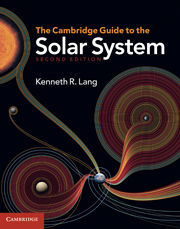Book contents
- Frontmatter
- Contents
- List of focus elements
- List of tables
- Preface to the second edition
- Preface to the first edition
- Principal units
- Part 1 Changing views and fundamental concepts
- Part 2 The inner solar system: rocky worlds
- Part 3 The giant planets, their satellites and their rings: worlds of liquid, ice and gas
- 9 Jupiter: a giant primitive planet
- 10 Saturn: lord of the rings
- 11 Uranus and Neptune
- Part 4 Remnants of creation: small worlds in the solar system
- Part 5 Origin of the solar system and extrasolar planets
- Author index
- Subject index
10 - Saturn: lord of the rings
from Part 3 - The giant planets, their satellites and their rings: worlds of liquid, ice and gas
Published online by Cambridge University Press: 05 August 2011
- Frontmatter
- Contents
- List of focus elements
- List of tables
- Preface to the second edition
- Preface to the first edition
- Principal units
- Part 1 Changing views and fundamental concepts
- Part 2 The inner solar system: rocky worlds
- Part 3 The giant planets, their satellites and their rings: worlds of liquid, ice and gas
- 9 Jupiter: a giant primitive planet
- 10 Saturn: lord of the rings
- 11 Uranus and Neptune
- Part 4 Remnants of creation: small worlds in the solar system
- Part 5 Origin of the solar system and extrasolar planets
- Author index
- Subject index
Summary
• Saturn has the lowest mass density of any planet in the solar system, low enough for the planet to float on water, and this means that Saturn is primarily composed of the lightest element, hydrogen.
• Saturn's rapid rotation has pushed its lightweight material out in the planet's middle, creating the most pronounced equatorial bulge of any planet.
• Saturn is just a great big liquid drop, covered by a thin atmosphere of gas, slightly smaller than Jupiter and less than a third of its mass.
• Liquid hydrogen is compressed inside Saturn's depths to form an electrically conducting, liquefied metal.
• There is no solid surface anywhere inside Saturn, though it might have a core of melted ice and molten rock that is about ten times as massive as the Earth.
• Saturn radiates almost twice as much energy as it receives from the Sun, and most of the planet's excess heat is generated by helium raining down into its liquid metallic hydrogen core.
• Saturn's rings are completely detached from the planet and separated from each other.
• The rings of Saturn are not solid, but instead composed of innumerable small water-ice particles and larger chunks of water ice.
• The icy constituents of Saturn's main A, B and C rings are as big as hailstones, snowballs and even icebergs; there are more smaller ones, but the big kind supply most of the ring mass. […]
- Type
- Chapter
- Information
- The Cambridge Guide to the Solar System , pp. 317 - 347Publisher: Cambridge University PressPrint publication year: 2011



